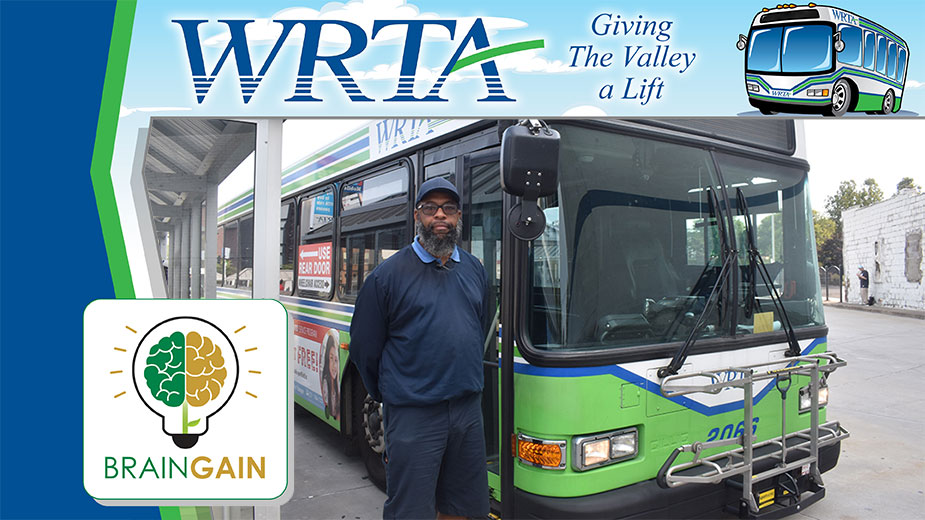YOUNGSTOWN, Ohio – John Ciruolo sits in a shelter at the Western Reserve Transit Authority’s downtown Youngstown terminal on a Friday morning.
Ciruolo, who resides in Liberty Township and works in construction, is waiting to board the 8 Market bus to get to his next work site. He doesn’t have a driver’s license, and the availability of the service is one of the reasons he moved here from Atlanta, he says.
“They didn’t have transportation like this,” he says. “It’s very convenient.”
The 8 Market route is the most used route WRTA operates. It makes 31 trips each weekday and 12 trips on Saturdays. In August, 12,861 patrons used the service; 11,389 rode it the month before.
In 2019, the 8 Market route served 197,113 passengers. In 2020, when pandemic workplace restrictions and closings were in force and fixed-route service was suspended by WRTA for more than a month, just 120,939 passengers used the service.
The roughly 13-mile round-trip route, which runs from Federal Station in downtown Youngstown to the Southern Park Mall in Boardman and back, links the city to Mahoning County’s main commercial district and provides access to employers, medical offices, restaurants and retail plazas.
At the Southern Park Mall, 8 Market connects to two loops. Boardman East runs on U.S. Route 224 toward shopping centers such as the Shops at Boardman Park and south to stops including St. Elizabeth Boardman Hospital and Assumption Village Skilled Nursing and Rehabilitation. The Boardman/Canfield loop takes Route 224 west to Canfield and the Mahoning County Career & Technical Center and back.
Louis Lee, a driver with WRTA for 13 years, says most of the riders on the 8 Market route use it to get to work, followed by those who use it for shopping. Lee is one of the current drivers on the route; drivers switch routes every three months.
Riders say they love the service “because it helps get them places they need to be,” he says.
“A lot of the same people ride to go to school, shopping or work. We have connections with a lot of the riders,” Lee says.
On this morning, about 14 passengers are on board as the bus departs from Federal Station, picks up a few passengers at a time at various stops on Market, and periodically discharges some as well.
A handful depart near the various buildings operated by Community Corrections Association, which provides residential and vocational assistance for men and women reentering society from the criminal justice system.
“I would estimate at any given time 80% of our population relies on public transportation at one point of their stay at CCA,” says David Stillwagon, CEO of Community Corrections Association.
The absence of bus service would have a “significant” impact on CCA, Stillwagon says. Some of the agency’s contracts specify that it must operate within a certain proximity of public transportation.
The bus continues along Market Street until the end of the first leg of the route at the mall, when the remaining passengers disembark to go to connecting buses or to the mall itself.
Then the 8 Market bus heads back north, picking up assorted passengers along the way and delivering them at stops as needed before returning to Federal Station.
Meet the People Riding the Bus
Among the 8 regular riders who use WRTA’s Market Route to get to their jobs in Youngstown and Boardman are J.D. Austin, Todd Roepke and Terrance Barnes.
Austin, who came to Youngstown from Chicago “to better my life,” was riding WRTA for the first time Sept. 13 because he’s saving money to buy a car. He was headed to his job at a Subway restaurant.
Without the service being available, “I could always use my feet,” he says.
Roepke, who lives in Youngstown, relies on the 8 Market bus to get to his job at Little Greek Fresh Grill in Boardman, where he has worked for two years. He rides the bus every day to get to and from work because it’s cheaper than paying for gas.
Without the service, work would be “harder to get to,” he says.
Barnes, who lives in Boardman, moved here from South Carolina because of family. He uses the service five days a week to get to and from the VXI Global Solutions call center in downtown Youngstown, where he has worked five months.
Like Roepke, he says he takes the bus to save on gasoline. Without WRTA being available, he would have to rely on rides from other people to get to and from work.
Theresa Newman of Youngstown, a WRTA passenger for at least 10 years, says she mainly uses the service for shopping and occasionally to get to the doctor’s office.
“I don’t have a car and it’s convenient for me,” she says.
The route also provides important service for retirees who either can’t drive or don’t want to.
“I use the bus because it’s convenient. It really is,” Anthony Pruden says.
Pruden, who lives in Youngstown, rides to his shopping and other errands.
“It takes me to all my stops and I don’t have a long way to walk. I’m a 65-year-old man,” he says, laughing. “I’m not young anymore.”
Carolyn Nored of Youngstown, who worked in housekeeping at Mercy Health 22 ½ years before she retired in February, takes the bus as many as three times a week to get to doctors or do her shopping, and used to use it to get to work.
“It’s a good thing that we have bus services so people can ride. If you didn’t have bus services, you’d have to take a cab,” she says.
Pictured: WRTA bus driver Louis Lee gets to know the riders.
